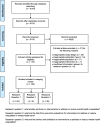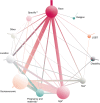Advancing mental health equality: a mapping review of interventions, economic evaluations and barriers and facilitators
- PMID: 32456670
- PMCID: PMC7251669
- DOI: 10.1186/s13643-020-01333-6
Advancing mental health equality: a mapping review of interventions, economic evaluations and barriers and facilitators
Abstract
Background: This work aimed to identify studies of interventions seeking to address mental health inequalities, studies assessing the economic impact of such interventions and factors which act as barriers and those that can facilitate interventions to address inequalities in mental health care.
Methods: A systematic mapping method was chosen. Studies were included if they: (1) focused on a population with: (a) mental health disorders, (b) protected or other characteristics putting them at risk of experiencing mental health inequalities; (2) addressed an intervention focused on addressing mental health inequalities; and (3) met criteria for one or more of three research questions: (i) primary research studies (any study design) or systematic reviews reporting effectiveness findings for an intervention or interventions, (ii) studies reporting economic evaluation findings, (iii) primary research studies (any study design) or systematic reviews identifying or describing, potential barriers or facilitators to interventions. A bibliographic search of MEDLINE, HMIC, ASSIA, Social Policy & Practice, Sociological Abstracts, Social Services Abstracts and PsycINFO spanned January 2008 to December 2018. Study selection was performed according to inclusion criteria. Data were extracted and tabulated to map studies and summarise published research on mental health inequalities. A visual representation of the mapping review (a mapping diagram) is included.
Results: Overall, 128 studies met inclusion criteria: 115 primary studies and 13 systematic reviews. Of those, 94 looked at interventions, 6 at cost-effectiveness and 36 at barriers and facilitators. An existing taxonomy of disparities interventions was used and modified to categorise interventions by type and strategy. Most of the identified interventions focused on addressing socioeconomic factors, race disparities and age-related issues. The most frequently used intervention strategy was providing psychological support. Barriers and associated facilitators were categorised into groups including (not limited to) access to care, communication issues and financial constraints.
Conclusions: The mapping review was useful in assessing the spread of literature and identifying highly researched areas versus prominent gaps. The findings are useful for clinicians, commissioners and service providers seeking to understand strategies to support the advancement of mental health equality for different populations and could be used to inform further research and support local decision-making.
Systematic review registration: Not applicable.
Keywords: Equality; Health economics; Inequalities; Mapping review; Mental health; Qualitative research.
Conflict of interest statement
The authors declare that they have no competing interests.
Figures


Similar articles
-
Beyond the black stump: rapid reviews of health research issues affecting regional, rural and remote Australia.Med J Aust. 2020 Dec;213 Suppl 11:S3-S32.e1. doi: 10.5694/mja2.50881. Med J Aust. 2020. PMID: 33314144
-
Behavioural modification interventions for medically unexplained symptoms in primary care: systematic reviews and economic evaluation.Health Technol Assess. 2020 Sep;24(46):1-490. doi: 10.3310/hta24460. Health Technol Assess. 2020. PMID: 32975190 Free PMC article.
-
Behavioural interventions for type 2 diabetes: an evidence-based analysis.Ont Health Technol Assess Ser. 2009;9(21):1-45. Epub 2009 Oct 1. Ont Health Technol Assess Ser. 2009. PMID: 23074526 Free PMC article.
-
Recovery schools for improving behavioral and academic outcomes among students in recovery from substance use disorders: a systematic review.Campbell Syst Rev. 2018 Oct 4;14(1):1-86. doi: 10.4073/csr.2018.9. eCollection 2018. Campbell Syst Rev. 2018. PMID: 37131375 Free PMC article.
-
Reducing unplanned hospital admissions from care homes: a systematic review.Health Soc Care Deliv Res. 2023 Oct;11(18):1-130. doi: 10.3310/KLPW6338. Health Soc Care Deliv Res. 2023. PMID: 37916580
Cited by
-
A happy home? Socio-economic inequalities in depressive symptoms and the role of housing quality in nine European countries.BMC Public Health. 2023 Nov 8;23(1):2203. doi: 10.1186/s12889-023-17070-z. BMC Public Health. 2023. PMID: 37940939 Free PMC article.
-
Alternative approaches to standard inpatient mental health care: development of a typology of service models.Int J Ment Health Syst. 2025 Apr 17;19(1):13. doi: 10.1186/s13033-025-00669-7. Int J Ment Health Syst. 2025. PMID: 40247283 Free PMC article.
-
Understanding inequalities in access to adult mental health services in the UK: a systematic mapping review.BMC Health Serv Res. 2023 Sep 29;23(1):1042. doi: 10.1186/s12913-023-10030-8. BMC Health Serv Res. 2023. PMID: 37773154 Free PMC article.
-
Interventions to improve social circumstances of people with mental health conditions: a rapid evidence synthesis.BMC Psychiatry. 2022 Apr 28;22(1):302. doi: 10.1186/s12888-022-03864-9. BMC Psychiatry. 2022. PMID: 35484521 Free PMC article. Review.
-
Benefits of a 12-week psychotherapy course for people with Parkinson's disease: a service improvement project.J Neurol. 2025 Jan 15;272(2):149. doi: 10.1007/s00415-024-12867-3. J Neurol. 2025. PMID: 39812847 Free PMC article.
References
-
- Department of Health and Social Care . Modernising the Mental Health Act: increasing choice, reducing compulsion. Final report of the Independent Review of the Mental Health Act 1983. UK: Department of Health & Social Care; 2018.
-
- Marmot M, Allen J, Goldblatt P, Boyce T, McNeish D, Grady M, et al. Fair society, healthy lives. The marmot review. Strategic review of health inequalities in England Post-2010. London: The Marmot Review; 2010.
-
- Her Majesty’s Stationery Office . Equality act. London: The Stationery Office; 2010.
-
- Her Majesty’s Stationery Office . Health and social care act. London: The Stationery Office; 2012.
-
- Sartorius N. Stigma and mental health. Lancet. 2007;370(9590):810–811. - PubMed
Publication types
MeSH terms
LinkOut - more resources
Full Text Sources
Medical
Miscellaneous

